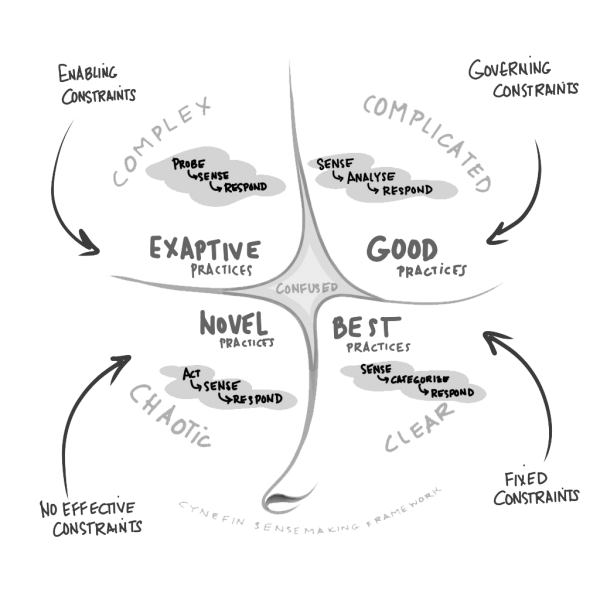
- Product Conception
According to Karina Hartmann, Head of Product and Innovation at SoftDesign, we are going through a unique moment in the Product Area: there is a constant review of concepts, new connections between theories, and the discovery of emerging tools. Even if, on one hand, it is exciting to work in such a lively area, this effervescence is reflected many times in a feeling of insecurity in people who work with product: Product Managers, Product Owners, and Product Designers.
The eagerness in putting into practice all methodologies and frameworks considered the most current ones in the product community, may end up deviating us from the actual goal of our work: to create value. In this sense, how Cynefin can help us with this challenge?
Cynefin is a conceptual framework created at IBM (1999) to solve an issue of how decisions were made at the company. It is not a tool per se, but a model to organize our minds, offering clearer and more objective ways of thinking about each problem we face.
Applying the framework on a daily basis to Product Owners, Cynefin helps with the challenge of handling the flood of ideas, issues, and processes. This way, it is possible to maximize the value of each delivery without feeling lost among so many techniques that come up every year.
The foundation of the model is the division of issues into four main quadrants: obvious things; complicated things; complex things; and chaotic things. There are other nuances as well but, in this article, we will focus on the four main quadrants that can help solve the most latent issues when it comes to the development of digital products.

Source: https://cdn.cognitive-edge.com/
When we talk about the quadrant of obvious things, we refer to those that are easy to understand and stable, that is, those that don’t change constantly. The cause-and-effect relationships are simple to understand in this type of issue: when making the right decision, we know what will happen, because the answer is always the same. For this reason, it is easy to establish a best practice to solve this type of issue, which has a single solution.
Evidently, we face situations where the person responsible for this issue still does not know the ideal way to resolve it, but there is such a way and it is obvious for those who master the topic addressed. This is the case of industrial processes, such as in a soda manufacturer, for example. Each part of the process is known and can be repeated easily.
If we don’t master our issue but know what we need to search to solve it, we are talking about the quadrant of complicated things. In this area, we put issues with cause-and-effect relationship that we don’t master and, for this reason, need to be analyzed by an expert on the topic.
Differently from obvious things, there is no single way for us to achieve the desired result; therefore, issues from the complicated quadrant don’t have a single path to follow, but good practices that can serve as inspiration to achieve the goal. It is like in medical procedures, where each case is assessed according to the patient and an acquired knowledge will be applied.
Complex things are those where the cause-and-effect relationships can only be studied in hindsight. At some point after the event, it may seem obvious, but still wouldn’t be a result that could be predicted beforehand. For this reason, there are no good practices to resolve complex causes; it is necessary to learn patterns along the way to solve this type of issue.
We can have some knowledge on isolate aspects, but the interaction between parts of the problem will only be understood when we fit each one of these independent variables. When we don’t know exactly what to look for, it is nearly impossible to find references in the topic. This is what happens in studies about climate change or when we face a new disease. The previous results do not guarantee the future results.
On the fourth quadrant, we have the chaotic things, related to events that are so sudden they don’t allow us to understand the scenario before making the decision. It is any completely unforeseen and urgent situation, when we are more concerned with saving lives, for example.
This is what happens in natural catastrophes or terrorist attacks where, even with specialists on the topic and recommended practices, those who own this knowledge are not available at the exact time the event occurs. For this reason, the people involved need to make the first emergency decisions, trying to contain the situation immediately.
We are already used to the idea that different issues require different solutions. Proof of it is that we usually suspect when someone presents a simple or obvious solution to an issue we consider complex. Cynefin facilitates organizing, indicating how we should behave when we face the situations from each quadrant:
In the Development of digital products, it is very rare work with obvious or chaotic scenarios. For this reason, we will focus on the Complicated and Complex quadrants.
In the beginning of the creation of a digital product, we are in a more complex scenario. We don’t know if our idea makes sense, if this is truly what we should be creating to solve the users’ point pains. At the ends, between the complex and chaotic quadrants, we want to have less uncertainty, we aren’t concerned yet with delivering the product.
At this moment, it doesn’t make sense to discuss productivity and efficiency, we need to talk about learning. Bringing to the reality of a startup, for example, this is the phase when we want to validate the issue and its options of solution. This is why it is so relevant to apply Design Thinking tools, favoring learning, and lean on innovation and disruption theories. Methods related to innovation, creativity and learning are very useful in this phase.
As we move towards a less complex and more complicated scenario, we achieve the moment of validating the product-market fit. In other words: evolving aspects of the product that make it fit the market we want to reach. Here, it makes sense to use methods that are no longer as open, but still absorb changes and adaptations, supporting learning about the experiments we are conducting.
It is the case for us to use Scrum or other Agile Methods. It is important to remember that we probably wouldn’t be able to use these methods in previous phases, because when we don’t know where to go, our efforts to structure work will probably not bring the result expected.
Once the complicated field is achieved, it is time to use more analytical methods, which will allow refining the solution. Only then we will get truly concerned with scale and support of the app, system or platform. We go from a Product Experimentation mindset to focus on a System Analysis or Software Architecture mindset, where we look for best practices to handle defined issues.
However, we know that currently products never achieve stability. Even after achieving scale, and having the feeling that some parts are stable (complicated domain), new ideas, challenges and business opportunities will continue to arise to enhance it, taking us back to the complex universe.
Using Cynefin to organize the issues we need to solve does not mean trying to fit our entire product into a single quadrant. Some parts of our solution may be complex and others may even be obvious.
Also, when we talk about the Development of Digital Products, we have different perspectives about the same issue – some parts may be simple from the business standpoint, but complex from the technical or usability standpoint, and vice-versa.
Cynefin is also contextual. That is, a situation that is obvious to one person may be complicated to another person. When we work with a field of knowledge that is completely different from what we are used to, an issue may have a simple solution, but we don’t know it yet – it is not in our repertoire. In this case, we need to resort to a specialist who helps us create an analysis for making decisions.
The discovery work starts with an input: an issue, a difficulty, an idea, etc. From then on, the product team must try to frame the situation in Cynefin, to be able to select the most adequate tools. This is roughly divided into:
| | High Uncertainty Complex | Medium Uncertainty Complex-Complicated | Low Uncertainty Complicated |
| Value Risk | Design Thinking Techniques; Ethnographic, qualitative, in-depth survey; Lean Startup and MVP No-Code/Low-Code. | Benchmarking. Development methods with quick feedback loops (Scrum, Kanban); Product metrics. | – |
| Business Risk | MVP; No-Code/Low-Code. | Development methods with quick feedback loops (Scrum, Kanban); | Use best practices from the business area. |
| Usability Risk | Quick Product Experimentation with prototypes. | Development methods with quick feedback loops (Scrum, Kanban); Product metrics. | Use the best practices from the usability area. |
| Technical Feasibility Risk | Proof of Concept (PoC). | Spike. | Use the best practices from the technical area. |
The techniques to be used greatly depend on your context and on what you already have on your toolbox (background). On the table below, we classify some tools to help materialize this proposal:
For example, if we are in a scenario where we want to solve a user’s issue, but do not have in-depth knowledge about it and don’t know what the best solution is to resolve it, our value risk fits the Complex quadrant from Cynefin. For these cases, therefore, Product Owner (PO) and Designer will need to choose techniques that favor, first and foremost, learning, such as qualitative in-depth surveys (interviews, observation).
The main goal for using Cynefin in decision making is enabling the product person to understand not only the best methodology for each phase but also have peace of mind about why applying or not applying each tool. It is important for us to be aware of the context and perspective we are working at; otherwise, we may make completely unproductive efforts.
Without this thinking structure, we risk applying theories and frameworks only because they are trendy: something that makes us, product people, suffer greatly is the glamorization of some tools, believing that there is a separation between innovative methods and outdated practices that no one else should do. The idea of Cynefin is precisely to bring this rationale that there are no glamorous tools but different techniques for every type of situation.
Are you unsure about which techniques to use in the creation of your Digital Product? Contact us, and our team of specialists will help you!
Experience having a reliable partner to your IT challenges. Let’s talk about our unique approach to discover and deliver outstanding solutions.


